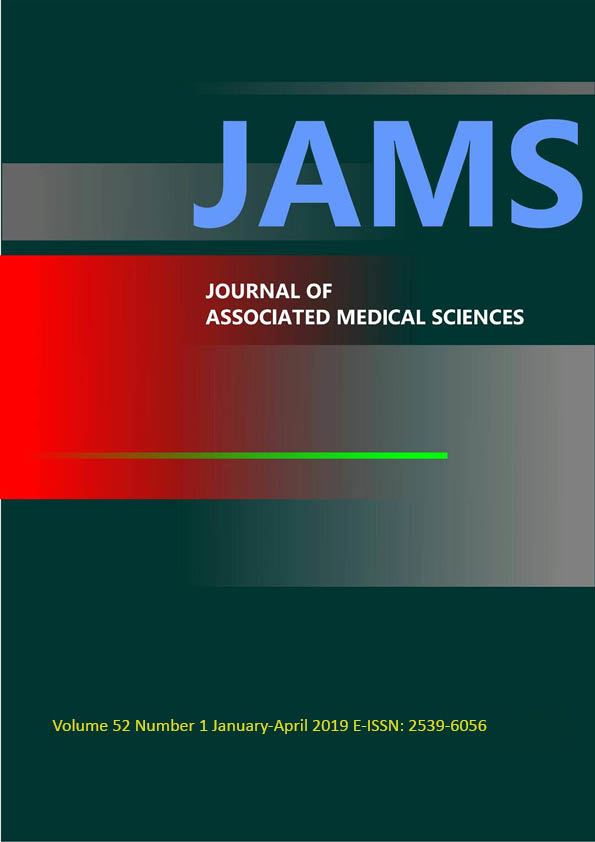Comparison of dynamics of HIV-1 coreceptor usage in a long-term antiretroviral treatment adolescent by genotypic and phenotypic assays
Main Article Content
Abstract
Background: Based on coreceptor usage, HIV-1 variants can be classified as R5, X4, and dual/mixed viruses. Currently, the determination of HIV-1 coreceptor usage can be performed by both phenotypic and genotypic assays. Although, the accessibility, simple, and low cost makes those genotypic assays a more feasible alternative to phenotypic assays, but they are not always accurate. Here, we discussed the coreceptor usage obtained by both assays in HIV-infected patient who acquired HIV-1 CRF01_AE and received antiretroviral therapy for at least 10 years.
Objectives: To determine the HIV-1 coreceptor usage by both genotypic and phenotypic assays at different three times in long-term antiretroviral treatment adolescent.
Materials and methods: The remained RNA was collected at different three times to determine the HIV-1 coreceptor usage by both phenotypic and genotypic assays. Firstly, HIV-1 V3 region was amplified, sequenced, and then V3 amino acid sequences were used as templates for prediction of coreceptor usage by genotypic predictors. Secondly, the entire gp160 envelope fragment was amplified from the same remained RNA to produce env-pseudotyped virus. The viruses were tested for coreceptor usage using U373.R5 and U373.X4 cells, and viral entry was assessed with luciferase activity measurement.
Results: From all time points at which coreceptor usage was determined, the genotypic results showed that the coreceptor usage trend to be more X4 phenotype using genotypic predictors, but it contrasted with phenotypic result which only voted to R5 phenotype. Although, the genotypic results showed the evolution of V3 amino acid sequences but it still not sufficient for coreceptor changed when confirmed with phenotypic assay. The presence of positively charged amino acid in V3 sequences causes a high net charge which can lead to mis-prediction by genotypic predictors.
Conclusion: This finding suggested that the predictions are not always accurate; a false prediction of X4 variants may lead to unnecessarily precluding patients who could have benefited from receiving CCR5 inhibitors whereas a false prediction of R5 variants may lead to the reemergence of X4-strains under CCR5 inhibitors pressure. Thus, the utilization of genotypic predictors should be carefully considered.
Article Details

This work is licensed under a Creative Commons Attribution-NonCommercial-NoDerivatives 4.0 International License.
Personal views expressed by the contributors in their articles are not necessarily those of the Journal of Associated Medical Sciences, Faculty of Associated Medical Sciences, Chiang Mai University.
References
[2] Koot M, Keet IP, Vos AH, de Goede RE, Roos MT, Coutinho RA, et al. Prognostic value of HIV-1 syncytium-inducing phenotype for rate of CD4+ cell depletion and progression to AIDS. Ann Intern Med. 1993 May 1;118(9):681-8.
[3] Richman DD, Bozzette SA. The impact of the syncytium-inducing phenotype of human immunodeficiency virus on disease progression. J Infect Dis. 1994 May;169(5):968-74.
[4] De Jong JJ, De Ronde A, Keulen W, Tersmette M, Goudsmit J. Minimal requirements for the human immunodeficiency virus type 1 V3 domain to support the syncytium-inducing phenotype: analysis by single amino acid substitution. J Virol. 1992 Nov;66(11):6777-80.
[5] Fouchier RA, Groenink M, Kootstra NA, Tersmette M, Huisman HG, Miedema F, et al. Phenotype-associated sequence variation in the third variable domain of the human immunodeficiency virus type 1 gp120 molecule. J Virol. 1992 May;66(5):3183-7.
[6] Jensen MA, Li FS, van 't Wout AB, Nickle DC, Shriner D, He HX, et al. Improved coreceptor usage prediction and genotypic monitoring of R5-to-X4 transition by motif analysis of human immunodeficiency virus type 1 env V3 loop sequences. J Virol. 2003 Dec;77(24):13376-88.
[7] Lengauer T, Sander O, Sierra S, Thielen A, Kaiser R. Bioinformatics prediction of HIV coreceptor usage. Nat Biotechnol. 2007 Dec;25(12):1407-10.
[8] Ng KY, Chew KK, Kaur P, Kwan JY, Khong WX, Lin L, et al. High prevalence of CXCR4 usage among treatment-naive CRF01_AE and CRF51_01B-infected HIV-1 subjects in Singapore. BMC Infect Dis. 2013;13:90.
[9] To SW, Chen JH, Wong KH, Chan KC, Chen Z, Yam WC. Determination of the high prevalence of Dual/Mixed- or X4-tropism among HIV type 1 CRF01_AE in Hong Kong by genotyping and phenotyping methods. AIDS Res Hum Retroviruses. 2013 Aug;29(8):1123-8.
[10] Phuphuakrat A, Phawattanakul S, Pasomsub E, Kiertiburanakul S, Chantratita W, Sungkanuparph S. Coreceptor tropism determined by genotypic assay in HIV-1 circulating in Thailand, where CRF01_AE predominates. HIV Med. 2014 May;15(5):269-75.
[11] Neogi U, Sahoo PN, Arumugam K, Sonnerborg A, De Costa A, Shet A. Higher prevalence of predicted X4-tropic strains in perinatally infected older children with HIV-1 subtype C in India. J Acquir Immune Defic Syndr. 2012 Apr 1;59(4):347-53.
[12] Raymond S, Delobel P, Chaix ML, Cazabat M, Encinas S, Bruel P, et al. Genotypic prediction of HIV-1 subtype D tropism. Retrovirology. 2011;8:56.
[13] Raymond S, Delobel P, Mavigner M, Cazabat M, Souyris C, Encinas S, et al. Genotypic prediction of human immunodeficiency virus type 1 CRF02-AG tropism. J Clin Microbiol. 2009 Jul;47(7):2292-4.
[14] Raymond S, Delobel P, Rogez S, Encinas S, Bruel P, Pasquier C, et al. Genotypic Prediction of HIV-1 CRF01-AE Tropism. J Clin Microbiol. 2013 Feb;51(2):564-70.
[15] Mulinge M, Lemaire M, Servais JY, Rybicki A, Struck D, da Silva ES, et al. HIV-1 tropism determination using a phenotypic Env recombinant viral assay highlights overestimation of CXCR4-usage by genotypic prediction algorithms for CRRF01_AE and CRF02_AG. PLoS One. 2013;8(5):e60566.
[16] Dimonte S, Mercurio F, Svicher V, D'Arrigo R, Perno CF, Ceccherini-Silberstein F. Selected amino acid mutations in HIV-1 B subtype gp41 are associated with specific gp120v(3) signatures in the regulation of co-receptor usage. Retrovirology. 2011;8:33.
[17] Labrosse B, Treboute C, Brelot A, Alizon M. Cooperation of the V1/V2 and V3 domains of human immunodeficiency virus type 1 gp120 for interaction with the CXCR4 receptor. J Virol. 2001 Jun;75(12):5457-64.
[18] Thielen A, Sichtig N, Kaiser R, Lam J, Harrigan PR, Lengauer T. Improved prediction of HIV-1 coreceptor usage with sequence information from the second hypervariable loop of gp120. J Infect Dis. 2010 Nov 1;202(9):1435-43.


